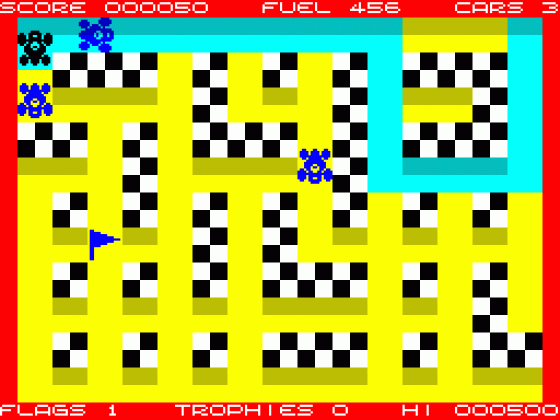
Micro Mart
 10th November 2005
10th November 2005
Categories: Preview: Software
Author: Shaun Bebbington
Published in Micro Mart #876
More new Spectrum games on the horizon it seems. Shaun investigates further...
Retro Mart: Hey Hey 16K

The question is posed in a song by M J Hibbert (available online at www2.b3ta.com/heyhey16k/) and that question is, "Hey hey 16K, what does that get you today?" As the song is something of an ode to the ZX Spectrum and its classic software, it’s rather apt that enthusiast Jonathan Cauldwell has an answer to its callings. Specifically, it gets you a new game that will work on the 16K rubber-keyed wonder machine.
Cauldwell’s latest addition to his binary library is called Turbomania, and is best described as a top-down racer similar to Rally X. It features the six times Formula Retro racing champion Tim Wrangle who is mysteriously transported to a parallel universe in which he is trapped in what appears to be a simple video game. Taking control of Wrangle's racing vehicle, you must cover every part of the raceway remembering to avoid the two or more opponents intent on stopping you in your tracks.
More information about this great little game can be found over at members.fortunecity.com/jonathan6/egghead, and even though the tape image is a mere 8K in size, it's well worth a look.
Keeping with the Spectrum for a minute, I've had words with Cronosoft’s master and commander Simon Ullyatt about future releases for the Speccy. He's informed me that Bob Smith, (programmer of Stranded for the ZX) is working on another puzzle game described as a mixture of Tetris and Dominoes. He's also looking for translators to help with the English version of the Russian game Stronghold, so all being well this too should be released by the budget label. Cronosoft's website is at www.cronosoft.co.uk. Don't forget to check Cronosoft's forum for the latest news and gossip.
Pinball Dreaming
The remarkable port of Pinball Dreams, which is currently making its way to the Commodore 64, has had further work to it. Parts of the current code have been debugged, which in turn has spared a few kilobytes of memory and made the flippers move more like the Amiga version. There's also a pixelated screen taken directly from the original game (and may I say, it looks rather nice considering the colour and resolution constraints of the C64), so we edge ever closer to being able to enjoy this game on everyone's favourite eight-bit machine.
When you consider that this project was initially going to require a RAM expansion unit of half a megabyte to be attached to the back of a C64 to run (as luck would have it, this hardware can be emulated with the WinVICE emulator), Pinball Dreams could well be the closest thing that C64 fans will have to a modern-day killer-app.
The latest news on this is regularly updated on the Lemon 64 forums over at www.lemon64.com/forum. If you're not already a member then you really should sign up today.
It's Not The Size...
It's a well-known saying used in many different circumstances: "It's not the size, it's what you do with it", or something along those lines. Nothing can be truer when we speak about retro computers and consoles. Consider for one moment that the text file of this article is just a bit bigger in size than the aforementioned Turbomania for the 16k Speccy, that many homebrew Atari 2600 games are 16k or less, and that a Commodore 64 has just 1/16th of a Megabytes in RAM.
Although an outsider might assume it, homebrew games aren't always over-simplistic. We only have to look as far as Thrust (2600) and the impending Pinball Dreams (C64) to see that.
So, while the rest of the gaming work is pushed to upgrade and upgrade, retro enthusiasts can look forward to superb productions without a great deal of fuss and expenditure. Perhaps Jason Kelk says it best: "The golden rule of developing is to have a good working knowledge of the hardware and design the game around that". Thankfully, many homebrew developers stick to this golden rule, and we're all better off for it.




